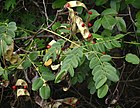Note: This is a project under development. The articles on this wiki are just being initiated and broadly incomplete. You can Help creating new pages.
Adenanthera pavonina - Ksharaka
Ksharaka, Adenanthera pavonina is a fast-growing deciduous tree with a spreading crown of light, feathery foliage. The tree is widely cultivated in the tropics for a wide range of uses. A very ornamental plant with fragrant, creamy flowers, it is often grown as a specimen and as a street tree.
Uses
Parts Used
Chemical Composition
Common names
| Language | Common name |
|---|---|
| Kannada | aane gulaganji |
| Hindi | baragunci, barighumchi, barigumchi |
| Malayalam | manjadi |
| Tamil | aanaikundrimani, anai kundumani |
| Telugu | bandi gurivenda, bandi gurvina, bandigurivenda, bandiguruginja, enugaguruginji |
| Marathi | NA |
| Gujarathi | NA |
| Punjabi | NA |
| Kashmiri | NA |
| Sanskrit | kamboji, ksharaka, kucandanah,tamraka |
| English | Coralwood tree |
Properties
Reference: Dravya - Substance, Rasa - Taste, Guna - Qualities, Veerya - Potency, Vipaka - Post-digesion effect, Karma - Pharmacological activity, Prabhava - Therepeutics.
Dravya
Rasa
Tikta (Bitter)
Guna
Laghu (Light)
Veerya
Sheeta (cold)
Vipaka
Karma
Pitta
Prabhava
Habit
Identification
Leaf
| Kind | Shape | Feature |
|---|---|---|
| Bipinnate | alternate | Leaves bipinnate, alternate, stipulate, rachis 14.5-62.5 cm long, stout, with a gland at the tip. Pinnae 2-3 pairs, leaflets 8-20, alternate |
Flower
| Type | Size | Color and composition | Stamen | More information |
|---|---|---|---|---|
| Bisexual | axillary spiciform racemes | Pale yellow | 10 | Flowering and fruiting is from January to September |
Fruit
| Type | Size | Mass | Appearance | Seeds | More information |
|---|---|---|---|---|---|
| A Pod | 10-25 x 0.7-1.5 cm | Follicle 2-angled, acute, straight to falcate to slightly twisted, spirally coiled after dehiscence | seeds 6-15, 8-10 x 7-9 mm, glossy, red | {{{6}}} |
Other features
List of Ayurvedic medicine in which the herb is used
Where to get the saplings
Mode of Propagation
How to plant/cultivate
The seed coats are extremely hard and requires scarification. It can be physically removed by rubbing against a rough surface such as sand paper or by soaking in warm water for 24 hours. They can then be sowed in polybags or nursery beds.
Commonly seen growing in areas
Photo Gallery
References
External Links
- Ayurvedic Herbs known to be helpful to treat Arthritis
- Ayurvedic Herbs known to be helpful to treat Burning sensation
- Ayurvedic Herbs known to be helpful to treat vomiting
- Ayurvedic Herbs known to be helpful to treat fever
- Ayurvedic Herbs known to be helpful to treat Hemorrhoids
- Herbs with Bark used in medicine
- Herbs with Leaves used in medicine
- Herbs with Heartwood used in medicine
- Herbs with Seeds used in medicine
- Herbs with common name in Kannada
- Herbs with common name in Hindi
- Herbs with common name in Malayalam
- Herbs with common name in Tamil
- Herbs with common name in Telugu
- Herbs with common name in Sanskrit
- Herbs with common name in English
- Habit - Tree
- Index of Plants which can be propagated by Seeds
- Index of Plants which can be propagated by Cuttings
- Herbs that are commonly seen in the region of Tropical area
- Herbs
- Plants of western ghats
- Fabaceae




